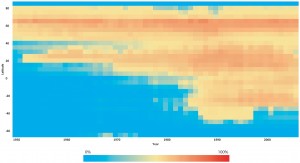 While it is widely-recognized that fishing boats have moved further offshore and deeper in the hunt for seafood, the Sea Around Us Project, in collaboration with the National Geographic Society, recently published in PloS ONE the first study to quantify global fisheries expansion.
While it is widely-recognized that fishing boats have moved further offshore and deeper in the hunt for seafood, the Sea Around Us Project, in collaboration with the National Geographic Society, recently published in PloS ONE the first study to quantify global fisheries expansion.
The study reveals that fisheries expanded at a rate of one million sq. kilometres per year from the 1950s to the end of the 1970s. The rate of expansion more than tripled in the 1980s and early 1990s – to roughly the size of Brazil’s Amazon rain forest every year.
Between 1950 and 2005, the spatial expansion of fisheries started from the coastal waters off the North Atlantic and Northwest Pacific, reached into the high seas and southward into the Southern Hemisphere at a rate of almost one degree latitude per year. It was accompanied by a nearly five-fold increase in catch, from 19 million tonnes in 1950, to a peak of 90 million tonnes in the late 1980s, and dropping to 87 million tonnes in 2005. Now we have run out of room to expand fisheries.
The image here (click to enlarge) shows a time series of areas exploited by marine fisheries by latitude class, expressed as a percentage of the total ocean area.

